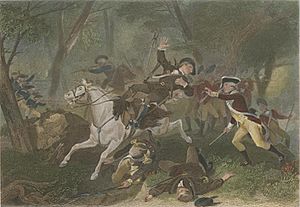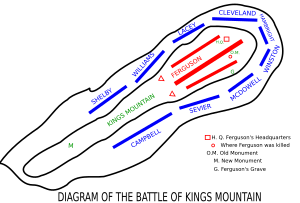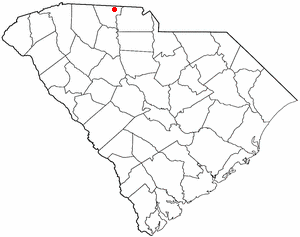Battle of Kings Mountain facts for kids
Quick facts for kids Battle of Kings Mountain |
|||||||
|---|---|---|---|---|---|---|---|
| Part of the American Revolutionary War | |||||||
 Engraving depicting the death of Patrick Ferguson, from a painting by Alonzo Chappel |
|||||||
|
|||||||
| Belligerents | |||||||
| Commanders and leaders | |||||||
|
|
||||||
| Strength | |||||||
| 900 | 1,105 | ||||||
| Casualties and losses | |||||||
|
|
||||||
The Battle of Kings Mountain was an important fight during the American Revolutionary War. It happened in South Carolina on October 7, 1780. This battle was between two groups of American fighters: the Patriots and the Loyalists. The Patriots wanted America to be free from British rule. The Loyalists wanted to stay loyal to Great Britain.
The Patriots won a big victory at Kings Mountain. The battle took place about 9 miles (14 km) south of the town of Kings Mountain, North Carolina. In this fight, the Patriot militia defeated the Loyalist militia. The Loyalists were led by a British officer named Major Patrick Ferguson. Many people call this battle "the war's largest all-American fight" because it was mostly Americans fighting each other.
Major Ferguson came to North Carolina in September 1780. His goal was to get more people to join the Loyalist militia. He also wanted to protect the main British army led by Lord Cornwallis. Ferguson warned the Patriot militias to give up their weapons or face serious trouble.
In response, Patriot leaders like Benjamin Cleveland, William Campbell, John Sevier, and Isaac Shelby gathered their forces. They decided to attack Ferguson and his Loyalists. Ferguson heard about the coming attack and tried to retreat to Lord Cornwallis's army. But the Patriots caught up to him at Kings Mountain, near the border with South Carolina.
The Patriot fighters surprised the Loyalists. They surrounded them and caused many casualties. After about an hour of fighting, Ferguson was shot and killed while trying to break through the Patriot lines. After their leader fell, the Loyalists surrendered. Some Patriots were very angry and wanted revenge for earlier fights. They kept fighting for a short time until their officers stopped them. Even though they won, the Patriots had to leave quickly. They were worried that Cornwallis's army might come after them.
This battle was a turning point in the war in the southern states. The Patriots had lost many battles before this one. So, this surprising victory greatly boosted their spirits. With Ferguson dead and his Loyalist forces defeated, Cornwallis had to change his plans. He gave up on invading North Carolina and went back to South Carolina.
Contents
Getting Ready for Battle
Major Patrick Ferguson was put in charge of the Loyalist militia in May 1780. His job was to go to the Tryon County area. He was supposed to find and organize Loyalist groups from people who supported Britain. He also had to protect the side of Lord Cornwallis' main army, which was in Charlotte, North Carolina.
The Battle of Musgrove's Mill
On August 18, 1780, about 200 Patriot fighters on horseback got ready. They were led by Colonels Isaac Shelby, James Williams, and Elijah Clarke. They planned to attack a Loyalist camp at Musgrove's Mill. This camp was important because it controlled the local food supply. It also guarded a river crossing.
The Battle of Musgrove Mill happened on August 19, 1780. It was near the Enoree River in South Carolina. The Patriots thought they would surprise a small group of Loyalists. But a local farmer told them that the Loyalists had recently gotten stronger. They had about 100 more Loyalist militia and 200 regular soldiers. These soldiers were on their way to join British Major Patrick Ferguson.
The whole battle lasted about an hour. Sixty-three Loyalists were killed, and many more were wounded. Seventy Loyalists were taken prisoner. The Patriots lost only about four men and had twelve wounded. After this victory, the Patriot leaders learned that a larger Patriot army had been defeated at Camden. So, they quickly left the area.
Chasing Shelby
Shelby's Patriot forces traveled 60 miles (97 km) with Ferguson chasing them. But they managed to escape. The victory at Musgrove Mill made the Patriots feel better after their big loss at Camden. It also showed that the Loyalists could not fully control the South Carolina countryside.
Shelby and his "Overmountain Men" went back across the Appalachian Mountains. They returned to their homes in what is now Elizabethton, Tennessee. By September 25, 1780, Colonels Shelby, John Sevier, and Charles McDowell had joined forces. They had 600 Overmountain Men. They also met with Colonel William Campbell and his 400 men from Virginia. They all gathered at Sycamore Shoals. This was before the Battle of Kings Mountain, which happened on October 7, 1780.
On September 2, Ferguson and his Loyalist militia marched west. They were chasing Shelby towards the Appalachian Mountain area. By September 10, Ferguson had set up a camp at Gilbert Town, North Carolina. Shelby said that Ferguson sent a message to the Patriot leaders. He told them to give up their weapons. If they didn't, he would "destroy their country with fire and sword."
Patriot leaders Isaac Shelby and John Sevier, from what is now northeast Tennessee, decided to fight back. They agreed to lead their militia against Ferguson.
Gathering at Sycamore Shoals
The Patriot leaders also sent a message to a Virginia militia leader, William Campbell. They asked him to join them at Sycamore Shoals. Campbell also asked Benjamin Cleveland to bring his militia from Wilkes County, North Carolina. The groups led by Shelby, Sevier, and Campbell met with 160 North Carolina militiamen. These were led by Charles McDowell and his brother Joseph. Campbell's cousin, Arthur Campbell, brought 200 more men from Virginia.
About 1,100 volunteers gathered on September 25, 1780, at Sycamore Shoals. These men were known as the "Overmountain Men". They were called this because they lived in the wilderness west of the Appalachian Mountains. Their journey was made easier because tensions with the Cherokee people had calmed down. This was thanks to the efforts of Benjamin Cleveland's brother-in-law, Joseph Martin.
The Overmountain Men crossed Roan Mountain the next day. They marched south for about thirteen days. They were getting ready to fight the British Loyalist forces. By September 30, they reached Quaker Meadows in Burke County, North Carolina. Here, they joined Benjamin Cleveland and his 350 men. Now, the Patriots had 1,400 fighters. They marched to South Mountain, North Carolina. The five colonels leading the Patriots (Shelby, Sevier, William Campbell, Joseph McDowell, and Cleveland) chose William Campbell as the main commander. But they all agreed to work together to lead their army.
Meanwhile, two men who had left the Patriot militia told Patrick Ferguson about the large army coming his way. Ferguson waited three days, and then he ordered his men to retreat. He wanted to reach Lord Cornwallis and the main British forces in Charlotte. He also sent a message to Cornwallis asking for more soldiers. But this message did not reach Cornwallis until the day after the battle. On October 1, Ferguson reached North Carolina's Broad River. There, he wrote another strong letter, telling the local militia to join him.
On October 4, the Patriot militia reached Ferguson's old camp at Gilbert Town. Thirty militiamen from Georgia joined them, eager to fight. On October 6, they reached Cowpens, South Carolina. There, they heard that Ferguson was east of them, heading towards Charlotte and Cornwallis. They hurried to catch him. American spies reported that Ferguson was camping on Kings Mountain with about 1,200 men. Ferguson decided to camp at Kings Mountain instead of pushing on to Charlotte, which was only a day's march away. He sent Cornwallis another letter asking for help.
Kings Mountain is a rocky, forested hill near the border between North and South Carolina. It looks like a footprint. The Loyalists camped on a ridge west of Kings Pinnacle, which is the highest point on Kings Mountain. The Patriot militia needed to move fast. They put 900 men on horseback and rode towards Kings Mountain. They left right away, riding through the night of October 6 and the morning of October 7. It rained the whole time. By sunrise on the 7th, they crossed the Broad River, which was fifteen miles from Kings Mountain. By early afternoon, they arrived and immediately surrounded the hill and attacked.
The Battle Begins
The battle started around 3 p.m. The 900 Patriots, including John Crockett (the father of Davy Crockett), approached the steep base of the western ridge. They formed eight groups, each with 100 to 200 men. Ferguson did not know that the Patriots had caught up to him and his 1,100 men. He was the only regular British soldier in his group. All the others were Loyalist militia from Carolina. There were also about 100 soldiers from New York who wore red uniforms. Ferguson had not thought it was necessary to build strong defenses for his camp.
The Patriots completely surprised the Loyalists. A Loyalist officer named Alexander Chesney later wrote that he did not know the Patriots were even close until the shooting started. As the screaming Patriots charged up the hill, Loyalist Captain Abraham de Peyster turned to Major Ferguson and said, "These things are bad – these are the yelling boys!" Two groups, led by Colonels John Sevier and William Campbell, attacked the "heel" of the mountain. This was the smallest area but the highest point. The other groups, led by Colonels Shelby, Williams, Lacey, Cleveland, Hambright, Winston, and McDowell, attacked the main Loyalist position. They surrounded the "ball" base next to the "heel" crest of the mountain.
No one in the Patriot army was in overall command once the fighting began. Each group fought on its own. They followed the plan they had agreed on: to surround and defeat the Loyalists. The Patriots crept up the hill, firing from behind rocks and trees. Ferguson gathered his troops and launched a desperate charge with their bayonets. Since the Patriots did not have bayonets, they ran down the hill and into the woods. Campbell soon got his troops back together, returned to the hill, and started firing again.
Ferguson ordered two more bayonet charges during the battle. This became the pattern of the fight. The Patriots would charge up the hill. Then the Loyalists would charge down the hill with bayonets, pushing the Patriots off the slopes and into the woods. Once the charge was over and the Loyalists went back to their positions, the Patriots would regroup in the woods. Then they would return to the base of the hill and charge up again. During one of these charges, Colonel Williams was killed, and Colonel McDowell was wounded. It was hard for the Loyalists to shoot accurately. This was because the Patriots were always moving and using cover. Also, the downhill angle of the hill made the Loyalists shoot too high.
After an hour of fighting, many Loyalists were killed or wounded. Ferguson rode back and forth across the hill. He blew a silver whistle to signal charges. Shelby, Sevier, and Campbell reached the top of the hill behind the Loyalist position. They attacked Ferguson's rear. The Loyalists were pushed back into their camp, where they started to surrender. Ferguson pulled out his sword and cut down any small white flags he saw. But he seemed to know that the end was near.
To try and encourage his men, Ferguson shouted, "Hurrah, brave boys, the day is ours!" He gathered a few officers and tried to break through the Patriot circle. But Sevier's men fired a volley of shots. Ferguson was shot and dragged by his horse behind the Patriot line. There, a Patriot officer demanded that he surrender. Ferguson shot and killed the man with his pistol. But he was immediately shot dead by several Patriots. When the Patriots found his body, they counted seven bullet wounds.
When the Loyalists saw their leader fall, they began to surrender. Some Patriots did not want to take prisoners. They wanted revenge for an earlier event called the Battle of Waxhaws or 'Tarleton's Quarter'. In that event, forces led by Banastre Tarleton had killed many American soldiers after they tried to surrender.
Loyalist Captain de Peyster, who was in charge after Ferguson died, sent someone with a white flag. He was asking for mercy. For several minutes, the Patriots ignored the white flag and kept firing. Many of them shouted, "Give 'em Tarleton's Quarter!" and "Give them Buford's play!" A large number of the surrendering Loyalists were killed or wounded, including the person carrying the white flag. When de Peyster sent out a second white flag, a few Patriot officers, including Campbell and Sevier, ran forward. They took control and ordered their men to stop firing. They took about 700 Loyalist prisoners.
What Happened Next
The Battle of Kings Mountain lasted 65 minutes. The Loyalists had 290 killed, 163 wounded, and 668 taken prisoner. The Patriot militia had 28 killed and 60 wounded. The Patriots had to leave quickly. They were worried that Cornwallis's army would come after them. Loyalist prisoners who could walk were taken to camps several miles from the battlefield. The dead were buried in shallow graves. The wounded were left on the field.
On October 20, the retreating Patriot army held quick trials for some Loyalists. They were accused of things like being disloyal to the Patriots or leaving Patriot militias. While stopped on the land of the Biggerstaff family, the American Patriots found 36 Loyalist prisoners guilty. Some Patriots who had once fought alongside these Loyalists, but later switched sides, spoke against them. Nine of the prisoners were hanged before Isaac Shelby stopped the trials. Many of the Patriots then left over the next few days. All but 130 of the Loyalist prisoners escaped while being led through the woods. The remaining prisoners finally made camp at Salem, North Carolina.
Lieutenant Anthony Allaire, a Loyalist from New York, was captured at the battle. He wrote in his diary about the months before the battle, the battle itself, and his time as a prisoner. He eventually escaped and made it back to the British forces.
Kings Mountain was a very important moment in the American Revolution. Before this, the Americans had faced many defeats and embarrassing moments in the Carolinas. These included the capture of Charleston and the American army there, and the destruction of another American army at the Battle of Camden. The surprising and clear victory at Kings Mountain greatly boosted Patriot morale. The Loyalist forces in the Carolina countryside were broken. Also, because Ferguson's command was destroyed and Patriot militias were a threat, Lord Cornwallis had to cancel his plans to invade North Carolina. He left Charlotte and went back to South Carolina. He did not return to North Carolina until early 1781.
In his book The Winning of the West, Theodore Roosevelt wrote that Kings Mountain "marked the turning point of the American Revolution." Thomas Jefferson called it "The turn of the tide of success." President Herbert Hoover spoke at Kings Mountain and said:
This is a place of inspiring memories. Here less than a thousand men, inspired by the urge of freedom, defeated a superior force entrenched in this strategic position. This small band of Patriots turned back a dangerous invasion well designed to separate and dismember the united Colonies. It was a little army and a little battle, but it was of mighty portent. History has done scant justice to its significance, which rightly should place it beside Lexington, Bunker Hill, Trenton and Yorktown.
In 1931, the United States Congress created the Kings Mountain National Military Park at the battle site. The park's main office is in Blacksburg, South Carolina. Hundreds of thousands of people visit the park each year.
Images for kids
See also
 In Spanish: Batalla de Kings Mountain para niños
In Spanish: Batalla de Kings Mountain para niños








